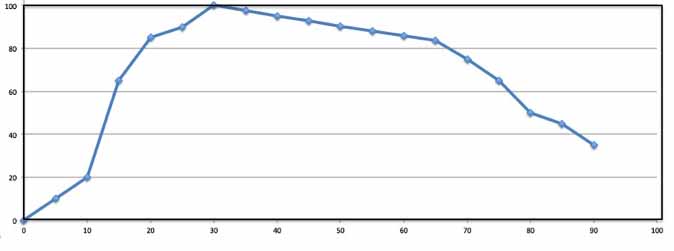I have been following Pablo’s running accounts with interest and envy.
I envy Pablo for three reasons. The first is that he can run. A lot of us who started running at relatively young ages eventually end up with knee problems that either slow us down significantly or stop us altogether. That’s me.
The second thing I envy is Pablo’s enthusiasm. When I was running well, about 30 years ago, I loved it and couldn’t imagine not running. I miss the enthusiasm as well as the running itself.
The third reason I envy Pablo is that his running is improving. I think that if I had continued the kind of running I was doing at 30, I would be slowing down by now. That thought made me do a little research. I wanted to look at how runners’ capabilities change over time.
There are short distance runners, medium-distance runners, and long-distance runners. I completed a marathon at age 27 in 1977 but never ran another. My running improved from that time to around 1984 when my knees ruined my running. In those days of graduate school, I ran a couple of 5-kilometer races, which I consider just over short distances. I ran some 10-k races, which I think fall firmly into the medium-distance category, and one 15-k race, which I think is a long distance. The marathon is the quintessential long distance race.
Pablo has completed a marathon, which makes him a runner, not a jogger. I’m not sure anyone who hasn’t completed a marathon can really understand what it means to run 26.2 miles. It’s a tremendous accomplishment. The running ability of the best marathoners is almost unbelievable. The best sprinters can run 100 yards in about 9.7 seconds, and then they’re done for. The best milers run at a pace of about 12.7 seconds per 100 yards, slower than a sprinter but not by much. The top marathoners run at a pace of about 16 seconds per 100 yards, only they do it for a little over two hours, or 461 times the 100-yard race. So I picked the marathon as the standard long distance to look at.
I came up with a guess at a plot of maximum theoretical running performance as a function of age. This is it, with running ability on the vertical axis and age in years on the horizontal axis.

Theoretical running ability as a function of age in years
Researchers at Marquette University found that the average age of the top five finishers from big world marathons, the ones that attract top marathoners from around the world, was 29.8 for men and 28.9 for women. That’s verging on truly aged in the world of extremely strenuous physical competitive sports, but from my perspective, deep into the barren and trackless desert of advancing age and increasing physical disability, those people seem positively callow. I assumed that those ages are the ages at which running ability peaks. So I called that peak 100 on the range of running ability.
I further assumed that there is some kind of physical training program that would result in peak performance at any given age if a runner faithfully followed the program without injury. If you started at the correct age (whatever that age is) and followed the program, you would end up at the maximum (100 on the plot) at age 29.8 for men and 28.9 for women. Before that time, you would be performing at the limit of your own capability, but it wouldn’t be as good as you would reach at your peak. I have no idea what the changing capability would be, but I assumed it would look something like what the plot shows at earlier ages. You would, of course, start out at zero at birth.
A slow decline starts after the peak. There is some research indicating a decrease in ability of good to excellent runners of between a half a percent and one and a half percent per year for a number of years, and then a drop of around 7 percent per year starting in the 40’s. The drop is even steeper after around 65.
I think this would be the envelope for any person running long distances. If a person trained properly from the right age, his or her performance would follow this curve. I assume (without any good reason) that if you don’t start at the beginning, you can never reach the level of the curve for your age, no matter how well you train. So if a theoretical person started running at 22, he might improve dramatically but would never reach the best he could have done for any age if he had started at the “correct” age. That’s my assumption although it might not be true.
That means that Pablo may well continue to improve for years to come, although he will probably never be competitive at the top level of marathoners. If, on the other hand, I had continued to run without injury, at some point in the past I would have begun to follow the downward curve. I would look back nostalgically at the times I had achieved in my youth, while every race I ran took longer and longer.
And still, I miss running. I often think of how nice it would be to run on the course I take when I walk the dogs. I might have had to throw away my running watch, but I would happily trade the best watch in the world for a pair of good knees.
![]() Good dog. Hey, Chloe, you heard what I told Zeke!
Good dog. Hey, Chloe, you heard what I told Zeke!![]() Everyone go to bed, right now!
Everyone go to bed, right now!![]() You, too, Sylvester, good kitty.
You, too, Sylvester, good kitty.![]() OK, I think everyone is in bed.
OK, I think everyone is in bed.